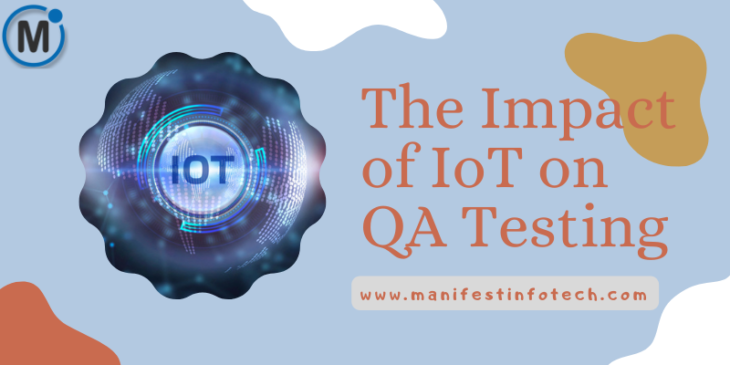
In the ever-expanding landscape of technology, the emergence of the Internet of Things (IoT) has ushered in a new era of connectivity, transforming the way we interact with devices and the world around us. With this technological revolution comes a significant impact on various domains, particularly in Quality Assurance (QA) testing.
𝐓𝐡𝐞 𝐈𝐨𝐓 𝐑𝐞𝐯𝐨𝐥𝐮𝐭𝐢𝐨𝐧 𝐚𝐧𝐝 𝐢𝐭𝐬 𝐐𝐀 𝐓𝐞𝐬𝐭𝐢𝐧𝐠 𝐈𝐦𝐩𝐥𝐢𝐜𝐚𝐭𝐢𝐨𝐧𝐬
𝟏. 𝐃𝐢𝐯𝐞𝐫𝐬𝐢𝐭𝐲 𝐚𝐧𝐝 𝐂𝐨𝐦𝐩𝐥𝐞𝐱𝐢𝐭𝐲
The proliferation of interconnected devices in IoT introduces a vast array of hardware, software, protocols, and communication standards. QA testing now confronts the challenge of ensuring seamless compatibility and functionality across this diverse ecosystem. Testing scenarios become multifaceted, demanding a comprehensive strategy to address various device interactions and potential failure points.
𝟐. 𝐒𝐜𝐚𝐥𝐚𝐛𝐢𝐥𝐢𝐭𝐲 𝐚𝐧𝐝 𝐏𝐞𝐫𝐟𝐨𝐫𝐦𝐚𝐧𝐜𝐞
IoT systems often involve a massive network of devices operating simultaneously, amplifying concerns related to scalability and performance. QA testers need to evaluate how systems handle increased loads, data influx, and real-time processing while maintaining optimal performance under varying conditions. Testing for scalability becomes paramount to ensure systems can handle expansions without compromising efficiency.
𝟑. 𝐒𝐞𝐜𝐮𝐫𝐢𝐭𝐲 𝐚𝐧𝐝 𝐏𝐫𝐢𝐯𝐚𝐜𝐲
As IoT devices collect and transmit sensitive data, the spotlight on security intensifies. QA testing must encompass rigorous security protocols to identify vulnerabilities, prevent data breaches, and safeguard user privacy. Ensuring encryption, authentication mechanisms, and secure data transmission becomes an integral part of QA processes.
𝟒. 𝐈𝐧𝐭𝐞𝐫𝐨𝐩𝐞𝐫𝐚𝐛𝐢𝐥𝐢𝐭𝐲 𝐚𝐧𝐝 𝐂𝐨𝐦𝐩𝐚𝐭𝐢𝐛𝐢𝐥𝐢𝐭𝐲
The interconnected nature of IoT devices emphasizes the need for seamless interoperability and compatibility. QA testing now extends beyond individual devices to evaluate how they collaborate within an ecosystem. Ensuring smooth communication, data exchange, and interoperability between diverse devices necessitates robust testing protocols.
𝐄𝐯𝐨𝐥𝐯𝐢𝐧𝐠 𝐐𝐀 𝐒𝐭𝐫𝐚𝐭𝐞𝐠𝐢𝐞𝐬 𝐢𝐧 𝐭𝐡𝐞 𝐈𝐨𝐓 𝐄𝐫𝐚
𝟏. 𝐀𝐝𝐚𝐩𝐭𝐢𝐯𝐞 𝐓𝐞𝐬𝐭𝐢𝐧𝐠 𝐅𝐫𝐚𝐦𝐞𝐰𝐨𝐫𝐤𝐬
Traditional testing methodologies may fall short in the IoT realm. QA teams are embracing adaptable frameworks that accommodate the complexities of interconnected devices. Agile and DevOps methodologies are increasingly integrated, allowing iterative testing and rapid deployment, aligning with the dynamic nature of IoT systems.
𝟐. 𝐀𝐮𝐭𝐨𝐦𝐚𝐭𝐢𝐨𝐧 𝐚𝐧𝐝 𝐀𝐈-𝐝𝐫𝐢𝐯𝐞𝐧 𝐓𝐞𝐬𝐭𝐢𝐧𝐠
The sheer scale and intricacy of IoT environments call for automation. AI-driven testing tools aid in simulating diverse scenarios, identifying patterns, and predicting potential failure points. Automation not only accelerates testing processes but also enhances accuracy and efficiency.
𝟑. 𝐅𝐨𝐜𝐮𝐬 𝐨𝐧 𝐄𝐧𝐝-𝐭𝐨-𝐄𝐧𝐝 𝐓𝐞𝐬𝐭𝐢𝐧𝐠
IoT ecosystems demand comprehensive end-to-end testing. QA strategies emphasize testing across the entire network, simulating real-world conditions to ensure seamless functionality, data integrity, and security at every stage of interaction.
𝟒. 𝐄𝐦𝐛𝐫𝐚𝐜𝐢𝐧𝐠 𝐂𝐨𝐧𝐭𝐢𝐧𝐮𝐨𝐮𝐬 𝐓𝐞𝐬𝐭𝐢𝐧𝐠
Continuous testing becomes imperative in the IoT landscape. QA teams integrate testing throughout the development lifecycle, enabling early bug detection, rapid feedback loops, and continuous improvements to deliver reliable, high-quality IoT solutions.
If you are looking for any services related to Website Development, App Development, Digital Marketing and SEO, just email us at nchouksey@manifestinfotech.com or Skype id: live:76bad32bff24d30d
𝐅𝐨𝐥𝐥𝐨𝐰 𝐔𝐬:
𝐋𝐢𝐧𝐤𝐞𝐝𝐢𝐧: linkedin.com/company/manifestinfotech
𝐅𝐚𝐜𝐞𝐛𝐨𝐨𝐤: facebook.com/manifestinfotech/
𝐈𝐧𝐬𝐭𝐚𝐠𝐫𝐚𝐦: instagram.com/manifestinfotech/
𝐓𝐰𝐢𝐭𝐭𝐞𝐫: twitter.com/Manifest_info
#IoTTesting #QualityAssurance #QAinIoT #IoTIntegration #TechTesting #IoTSecurity #QAstrategies #SmartDevicesQA #IoTPerformance #ConnectedTesting #IoTInnovation #QAChallenges #IoTSecurityTesting #DigitalQuality #TestingMethodologies #IoTCompatibility #QualityControl #IoTNetworks #QAautomation #IoTDevOpsTesting